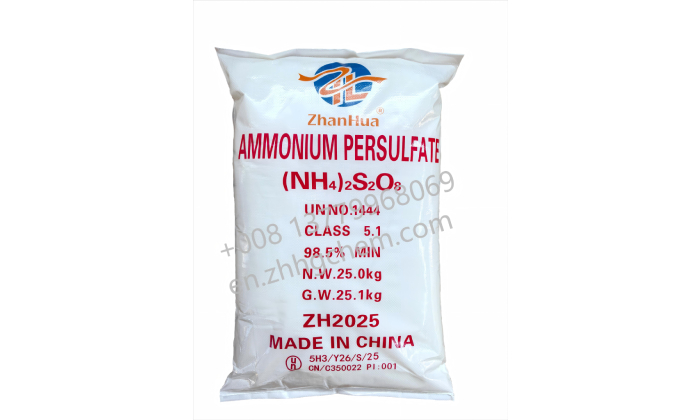Ammonium Persulfate, as an important oxidant and initiator, is widely applied in multiple industrial fields. Its high activity and strong oxidizing property make it play an indispensable role in the reaction processes of industries such as electronics, petroleum, environmental protection, and new energy. However, when used as an initiator, the concentration control of Ammonium Persulfate is not arbitrary but requires strict compliance with a series of process standards and technical specifications. This is not only related to the efficiency and safety of the reaction but also directly affects the quality and performance of the products. Therefore, exploring the concentration requirements of industrial-grade Ammonium Persulfate as an initiator has important reference value for technicians and production managers in related industries.

In a chemical reaction system, the dosage (or concentration) of the initiator directly affects the reaction rate, the quality of the products, and the production cost. For the application of industrial-grade Ammonium Persulfate as an initiator, the selection of its dosage needs to comprehensively consider the characteristics of the reaction system, the reaction conditions, and the performance requirements of the final products.
Generally, if the dosage of the initiator is too low, it may lead to an insufficient reaction rate, prolong the reaction time, and reduce the production efficiency. On the other hand, if the dosage is too high, it may increase the probability of side reactions, affect the purity of the target product, and even cause waste of raw materials. Therefore, scientifically and reasonably controlling the dosage of the initiator is the key to ensuring the efficient and stable progress of the reaction.
In the field of polymer synthesis, industrial-grade Ammonium Persulfate is often used as an initiator for free radical polymerization reactions. For example, in the polymerization process of synthesizing high-molecular materials such as synthetic rubber and plastics, the dosage of the initiator (usually expressed as a mass fraction) needs to be precisely controlled. Generally speaking, the mass fraction range of the initiator is 0.01% to 1%, and the specific value needs to be comprehensively optimized according to factors such as the type of polymer, the properties of the monomer, the reaction temperature, the reaction time, and the target molecular weight. Ammonium Persulfate decomposes thermally or through redox reactions in solution to generate sulfate radicals (SO₄•−), which in turn initiate the polymerization of monomers. Its oxidizing property endows this system with high reaction activity, making it suitable for various processes such as emulsion polymerization and suspension polymerization. As a globally renowned producer of per-sulfate products, Fujian ZhanHua Chemical's industrial-grade Ammonium Persulfate products are characterized by high purity and low impurities (with extremely low heavy metal content), which can meet the strict requirements for the concentration and stability of initiators in different polymerization processes, providing a reliable raw material guarantee for polymer synthesis.
In the petrochemical industry, Ammonium Persulfate is widely used in the oxidation reaction during oil well stimulation processes. This process usually requires strict control of the dosage of Ammonium Persulfate to ensure the full progress of the reaction. However, the control of the dosage is of vital importance. An excessively high dosage may lead to an overly vigorous reaction and even pose a safety risk, while an excessively low dosage may fail to achieve the expected stimulation effect.
With its rich industry experience and strict quality control system, Fujian ZhanHua Chemical can provide customers with Ammonium Persulfate products that meet the requirements of different processes, helping customers achieve efficient production while ensuring safety.
In addition, in the field of environmental protection, Ammonium Persulfate is also used for wastewater treatment and the degradation of organic pollutants. In this application, the selection of the dosage of Ammonium Persulfate directly affects the efficiency of the oxidation reaction and the treatment effect. Usually, for different characteristics of pollutants, the dosage of Ammonium Persulfate needs to be optimized and adjusted. For example, when treating high-concentration organic wastewater, a relatively high dosage may be required to improve the oxidation efficiency, while when treating low-concentration wastewater, the cost can be reduced by lowering the dosage.
It is worth mentioning that the control of the dosage of industrial-grade Ammonium Persulfate not only needs to consider the requirements of the reaction system but also ensure its stability during storage and transportation. Due to the strong oxidizing property of Ammonium Persulfate, it is easily affected by temperature and humidity. Therefore, scientific storage and transportation measures need to be taken in actual operations. Fujian ZhanHua Chemical strictly implements international standards in the product production and packaging processes to ensure the stability and safety of each batch of products, thereby providing customers with high-quality raw material support.
The control of the dosage of industrial-grade Ammonium Persulfate is an important part of process design. A reasonable selection of the dosage can not only improve the reaction efficiency but also ensure the safety and reliability of production. Fujian ZhanHua Chemical's professionalism and technical strength in this field have provided solid support for related industries. Whether in the domestic or international market, the products of Fujian ZhanHua Chemical have won wide recognition for their high quality and stability. In the application field of industrial-grade Ammonium Persulfate, scientifically controlling the dosage level is not only an optimization of the process but also a promotion of the development of the industry.